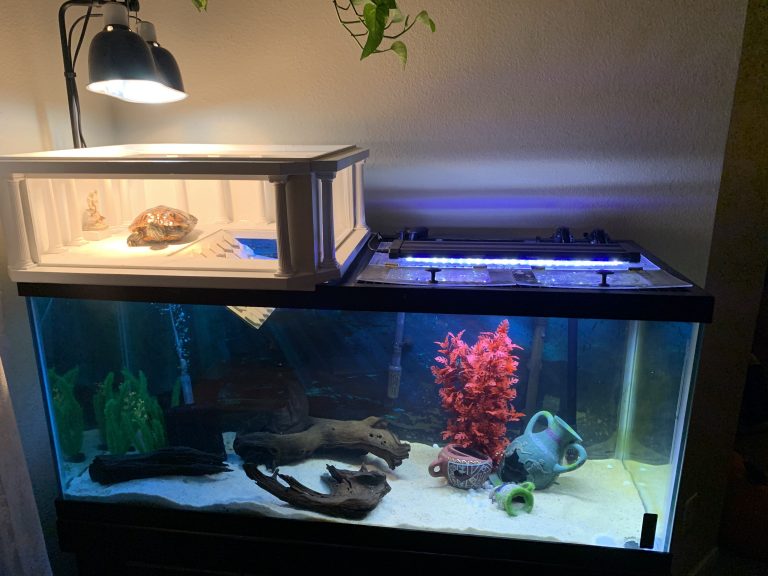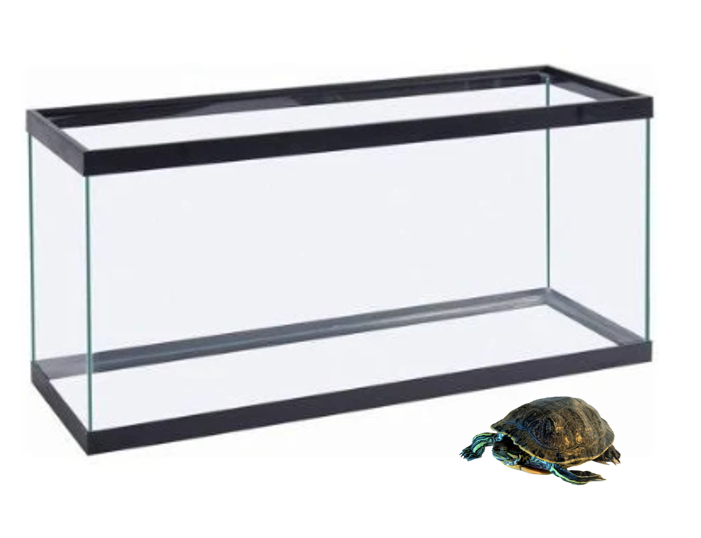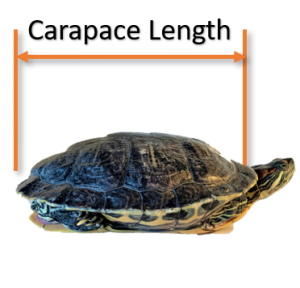Turtle Tanks
Turtle Tanks (Aquariums) and Tubs
Long Live Your Turtle LLC is an Amazon Associate and will earn a small commission from qualifying purchases when Amazon product links on this page are utilized. Additional Disclaimer information is provided at the bottom of this page.

Key Turtle Tank Tips:
- Tank should be size base on turtle carapace length where 1” ~ 10 gallon
- Aquarium should be in great condition, turtles can be rough and you never want to spring a leak
- Don’t by narrow or tall specific tanks as they are not space optimized for turtles
- Tanks need an adequate cover to prevent escape but also allow for filter/heater and other components to fit
- Tank water needs to be within healthy parameters and the right temperature for your turtle


Turtle tanks are typically sized based on your turtle’s carapace length. Rule of thumb is 10 gallons per 1″ carapace length. But of course, bigger is always better! No links are provided to buy tanks online here. Most likely, you will be paying 2 to 5 times the price online compared to your local pet store. You can snag amazing tank deals at Petco during their dollar per gallon sale (up to 75 gallon tanks). See below for recommended tank sizes. (LLYT is not sponsored, endorsed nor does it have any affiliation with Petco)
Tank Sizing Guide:
|
Turtle Size |
Tank Size |
|
1-2” |
20 Gallon* |
|
3-4” |
40 Gallon |
|
5-6” |
55 Gallon* |
|
6-8” |
75 Gallon |
|
9-11” |
150 Gallon** |
|
12”+ |
300 Gallon** |
*Avoid buying a “tall” or “narrow” specific tank
**Consider getting a turtle tub or setting up a pond
Key Turtle Tub Tips:
- Tub should be sized similar to a tank, turtle carapace length where 1” ~ 10 gallon
- If tub has a drain plug, make sure it does not leak!
- Buy as big as you can!
- Tubs need an adequate cover or walls to prevent escape but also allow for filter/heater and other components to fit
- Tub water needs to be within healthy parameters and the right temperature for your turtle


Turtle tubs are a little different than the typical aquarium tank. For starters, they sit close to or on the ground or floor. Second, you look down at them creating a whole new perspective when setting up how the enclosure looks. Lastly, equipment built for the aquarium hobby is rarely suited to install directly onto a turtle tub and usually requires a little modification (e.g. filter tubing).
Budget TIP: Like a tank, Browse Craigslist or Facebook Marketplace for used stock tanks. Sometimes you can find excellent deals. Beware of stock tanks used on a 4 season farm or just used extensively. The drain plug typically built into these tubs can leak. It is a cheap easy replacement that should always be considered. Test fill the tub for a few days in a leak-safe place before using it, especially if you are locating inside your home.
Maintenance TIP: If your are installing you tub indoors on the first floor where the using the drain plug is impractical, elevate the tub using cinderblocks and plywood. The more elevation you can gain, the stronger syphon you can create to drain the tub (out a window or door).
Enclosure TIP: You cannot fill up a turtle tub (stock tank, metal tub, etc) and count on it being escape proof without modification. Turtle’s are escape artists and can climb even several inch high walls. Consider this when setting up the basking area. There are three general options for a basking area. A tub filled about 75% filled with logs or stones sticking out of the water. A tub filled 100% with walls or a fence surrounding the tub so that the turtle cannot escape and logs or stones sticking out of the water. Lastly, a tub with a wall or fence and a basking platform built into the side of the tub (like a dock).
Tub Filters: Filters used for turtle tubs must be carefully thought out. Hang on the back filters most likely will not work. That leaves internal and canister filters. Internal filters are great if you can afford the space hogger. Otherwise, canister filters are excellent options for large volume tanks. However, you do need to keep one thing in mind if you are planning to use a canister filter. A majority of turtle tubs will be on the ground or floor. Many canister filters work properly when underneath a tank. Some even require it. There are some exceptions and in some cases its just a small decrease in performance. It is recommended that you elevate your turtle tub, if possible, at least a few inches to help the filter out a bit. For example you could use one or two layers of cinderblocks with a plywood piece between the top layer and the tub. The LLYT turtle tub is currently on one layer of cinderblocks. The setup has a Fluval FX6 running next to it. There was no noticeable decrease in performance.
Tub Sizing Guide:
Turtle Size | Tub Size |
1-2” | 20 Gallon* |
3-4” | 40 Gallon* |
5-6” | 55 Gallon* |
6-8” | 75 Gallon |
9-11” | 150 Gallon** |
12”+ | 300 Gallon** |
*Not the most practical pricewise, consider starting big!
**Consider setting up an outdoor pond if you live in a climate that could support the heat/seasonal needs
Longliveyourturtle.com is an educational site for aquatic turtle owners, future owners and hobbyists interested in general turtle care information. All information provided is accurate to the best of Long Live Your Turtle LLC’s knowledge and belief, but is presented for educational and sometimes entertainment purposes only. No information on this site should be considered authoritative with respect to human health or animal health and husbandry. Full disclaimer can be found at here.
MORE ON TURTLE TUBS COMING SOON!